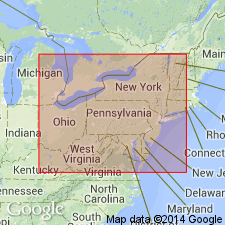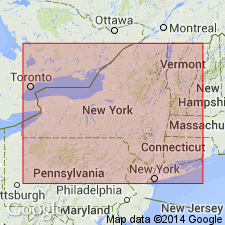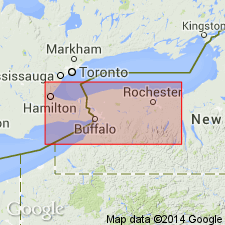
- Usage in publication:
-
- Power Glen formation
- Modifications:
-
- Named
- Dominant lithology:
-
- Shale
- Sandstone
- Limestone
- AAPG geologic province:
-
- Appalachian basin
Summary:
"The name Power Glen is introduced for the shales overlying the Whirlpool and underlying the Grimsby in the Niagara Falls region, and is correlated with the Manitoulin and lower part of the Cabot Head formations." Assigned to the Cataract Group. Contact with the underlying Whirlpool formation is transitional, and is everywhere drawn at the top of the massive sandstone beds in the Whirlpool formation. Unit consists of 48 ft of shales, with interbedded sandstones and limestones. This distinct facies can be recognized from Niagara gorge to Stoney Creek. Eastward the shales grade into the red Medina formation and westward into Manitoulin dolomite and Cabot Head shales. The Power Glen is green to dark gray, fissile, calcareous to arenaceous shales, interbedded with thin bands of light gray, fine-to medium-grained, calcareous sandstones. Ferruginous limestone and intraformational conglomerate bands are present in the upper beds. The lower contact of the Power Glen formation may be placed at the base of a sandy transition zone, 1 ft thick, of alternating thin sandstone and shale beds, which lies between the massive Whirlpool sandstone and overlying shale facies and was formerly assigned to the Whirlpool formation. Red shales or sandstones of the Grimsby formation conformably overlie the gray Power Glen shales. Age is Early Silurian.
Source: GNU records (USGS DDS-6; Reston GNULEX).

- Usage in publication:
-
- Power Glen Formation
- Modifications:
-
- Revised
- AAPG geologic province:
-
- Appalachian basin
Summary:
The Medina Group comprises 11 facies, which can be organized into three facies associations. The previously defined color-based formations do not conform with lithic correlations except for the Whirlpool and Manitoulin. A formal major revision is being proposed by Brett and others (in press) and Duke and others (in press). The newly revised Medina Group will include the Whirlpool Sandstone at its base (virtually unchanged), the overlying Jolley Cut Formation (a tentative renaming of the Manitoulin), the Balls Falls Formation (new), the Art Park Phosphate Beds (new), the Devils Hole Formation (new), the Grimsby Formation (revised), the Power Glen Formation (revised), the Thorold Formation (revised), the Cambria Formation (new), and the Kodak Formation (resurrected). The Medina unconformably overlies Queenston Shale; unconformably underlies Clinton Group.
Source: GNU records (USGS DDS-6; Reston GNULEX).

- Usage in publication:
-
- Power Glen Shale*
- Modifications:
-
- Revised
- Redescribed
- Dominant lithology:
-
- Shale
- Sandstone
- Dolomite
- Siltstone
- Limestone
- AAPG geologic province:
-
- Appalachian basin
Summary:
The Power Glen Shale of the Medina Group is revised to include only the lower part of the Power Glen Shale of Rickard (1975). The upper part is now considered the Devils Hole Sandstone (new) and the basal beds of the Grimsby Formation. The Power Glen consists of sparsely fossiliferous dark-gray to greenish-gray marine shale with light-gray to bluish-gray, hummocky cross-stratified to bioturbated, quartzose sandstone interbeds; also contains interbeds of dolomite, calcareous siltstone, and sandy limestone. Well exposed along Niagara Street railroad cut, Lockport, Niagara Co., NY. Thickness ranges from 20.0 to 27.5 feet. Gradationally overlies the Whirlpool Sandstone and underlies the Devils Hole Sandstone with a sharp contact. The Power Glen is of Early Silurian (Llandoverian) age. [Report uses Early and Late Silurian time scale of Harland (1982).]
Source: GNU records (USGS DDS-6; Reston GNULEX).
For more information, please contact Nancy Stamm, Geologic Names Committee Secretary.
Asterisk (*) indicates published by U.S. Geological Survey authors.
"No current usage" (†) implies that a name has been abandoned or has fallen into disuse. Former usage and, if known, replacement name given in parentheses ( ).
Slash (/) indicates name conflicts with nomenclatural guidelines (CSN, 1933; ACSN, 1961, 1970; NACSN, 1983, 2005, 2021). May be explained within brackets ([ ]).

